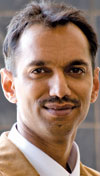

Just as private organisations depend on security systems to monitor activities in and around their premises and to control the access of people into their facilities, parastatals have similar needs. Hi-Tech Security Solutions spoke to Telkom and CSIR about the changing face of security in their domain.
CSIR

Sibusiso Mngomezulu is head of security for the CSIR. He says that on a general government level there are both external and internal security risks and threats. Primarily, the external threats derive from political instability and IT hacking as well as attacks from outside our borders, from foreign intelligence agencies. Internal risks are corruption, poverty and unemployment, as well as insider threats.
The first line of defence is currently CCTV and video analytics. He points out that the CSIR is currently working on a robotised security patroller that will move around the perimeter of a property. This eliminates the risks and issues associated with human security guards – typically fatigue, illness and collusion. He continues that the organisation is also developing software that will see all security systems integrating seamlessly and effortlessly. Integration and IP in fact feature very strongly in the CSIR’s security project portfolio.
With regard to the forward drive to make security more accountable and seemingly more effortless, Mngomezulu points out that manual visitor registers will probably be allocated to the archives in the near future. Improvements in biometric technology have seen a rapid move towards electronic registration of visitors and employees. He says that facial recognition, in particular, is now gaining momentum as the technology becomes more affordable and accessible. Where budgets dictate otherwise, fingerprint technology still plays a huge role in capturing requisite visitor data. The upside to electronic registration is that the coordination of visitors is more readily facilitated and traceable.
Another area that has seen huge steps forwards is in the replacement of K9 guarding with PTZ cameras, armed with video analytics. He explains that this has resulted in substantial savings in terms of manpower and provides a stronger chain of evidence for investigatory purposes.
In terms of its access control, the CSIR believes that this is key to the protection of its personnel. However, in order to gain maximum benefit from the system it is critical that data is correctly captured from the outset. He explains that in areas where there are high levels of sensitivity, access control is conducted on an extremely stringent basis using fingerprint biometrics, combined with other authenticating measures.
He adds that it is imperative to ring-fence those areas where intellectual property is at risk. This entails implementing a strict set of rules which govern access to these areas. In this instance dual protection is provided by the security department and the IT department.
The theft of copper posed a large problem for the CSIR. The deployment of CCTV cameras has acted as a major deterrent for would-be copper thieves and at the same time has made employees more aware of safety in the workplace. In addition, surveillance and video analytics provide a bird’s eye view of the laboratories, acting as both an occupational health and safety (OHS) tool, but likewise as a protection device for valuable equipment. He says that 20% of the CSIR’s CCTV cameras are automated to zoom in on potential hot spots when alarms are activated.
He continues that the organisation has had a mixed reaction to its security measures from the public. On the positive side, visitors see the cameras and access control as being a necessary security measure. The naysayers on the other hand believe that it is an invasion of privacy.
Based on the success of the current CCTV installation, Mngomezulu says that the CSIR will be adding further cameras in the future. “We have a 6,5 km perimeter so we need extensive coverage. In addition, we would like to see more coverage in our foyer areas. One possibility for the perimeter is the inclusion of thermal cameras.”
Mngomezulu says that he would like to see legislation being enforced on the guideline use of CCTV footage for prosecutory purposes.
Telkom

Sam Moodley, manager at Telkom (Security Services) says that although physical threat is apparent, the theft of intellectual property and on IT networks is an even bigger threat to Telkom. He explains that the organisation has implemented measures that detect and disable the bugging of offices. In addition, sensitive information contained in faxes is shredded by pre-screened, reputable companies who specialise in this area.
According to Moodley, security is fit to purpose and sees a combination of manned security, who provide a physical presence and response, and the forensic capabilities of a technology driven system.
He says that the technology is adapted to suit both the budget and the environment. Typically, one could have intruder detection, CCTV cameras and an armed response, or if the budget allows, a full-time security guard. He points out that it is important to establish categories of risk then factor in the environmental constraints when designing a security solution.
He adds that security will not be able to keep up with the advance of IT in terms of quick evolution. An example is the constant introduction of new PC and Apple Mac technology, while security technology proceeds at a much more sedate pace. “Security can often be viewed as a place-and-forget purchase. Upgrades are often put on the backburner as current systems are doing what they are supposed to do. Justifying an upgrade on a security system is a lot harder than asking for the latest Windows software, antivirus software or firewall.”
In terms of return on investment, this is often not patently apparent and should rather be viewed in terms of whether protecting human and physical assets and preventing crime against them is working. Successful safety and security is then the determining factor as far as ROI is concerned.
Moodley says that surveillance cameras are helpful from a business value add perspective in terms of monitoring employee-customer interactions. “When there is a dispute by a customer, we can view the footage and ascertain the exact course of events and then proceed in an educated manner. In addition, surveillance allows us to ensure compliance with OHS regulations and also provides crucial feedback which can be used for training purposes to ensure complete streamlining of processes.”
When implementing new security systems, Moodley says that inter-personnel communication is vital. All employees affected by the introduction of security systems receive regular information regarding the system in the months leading up to the launch date. By implementing systems in a phased rollout fashion, corrective measures can be taken based on feedback about the system.
According to Moodley, 50 sites have gone online in the past five months, with approximately 5000 cameras and 2000 access doors installed. The move towards electronic security started in 2001 and will continue until all sites are online. He cites a customer centre in the CBD as being a great success story. With the introduction of the surveillance not only has Telkom seen a positive effect, but neighbouring buildings have commended Telkom on contributing to reduced vandalism and robbery incidents.
Such is the success of the rollout that Moodley says at least 60% of Telkom’s sites will be covered by some combination of security system using the Telkom converged network. It is about implementing an integrated technology program that has sustainability with prospects of further development as technology and demands evolve.
| Tel: | +27 11 543 5800 |
| Email: | malckey@technews.co.za |
| www: | www.technews.co.za |
| Articles: | More information and articles about Technews Publishing |
© Technews Publishing (Pty) Ltd. | All Rights Reserved.